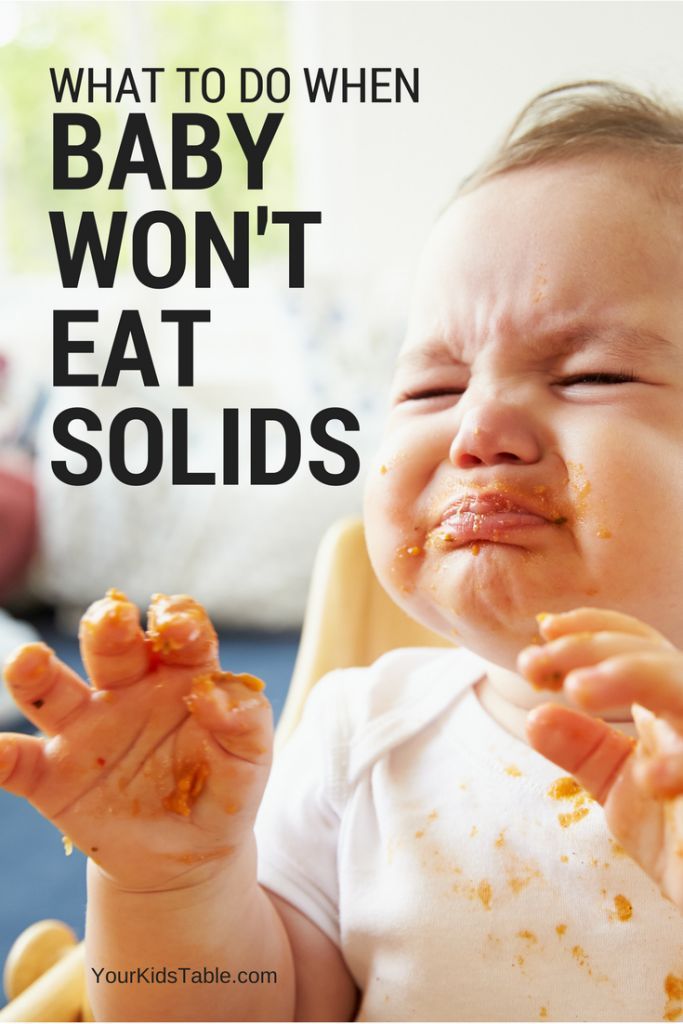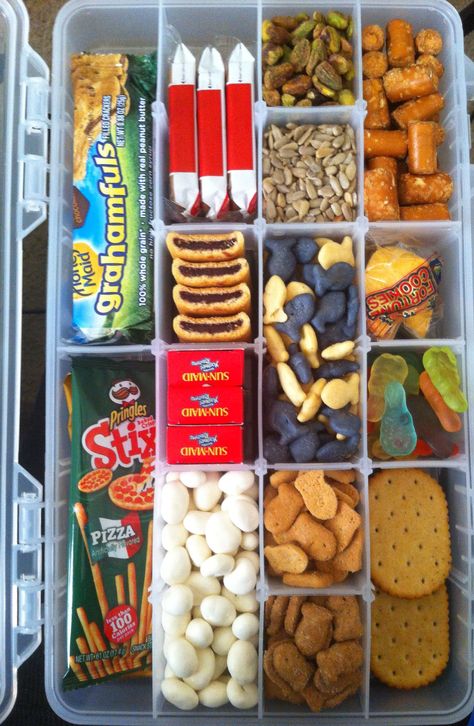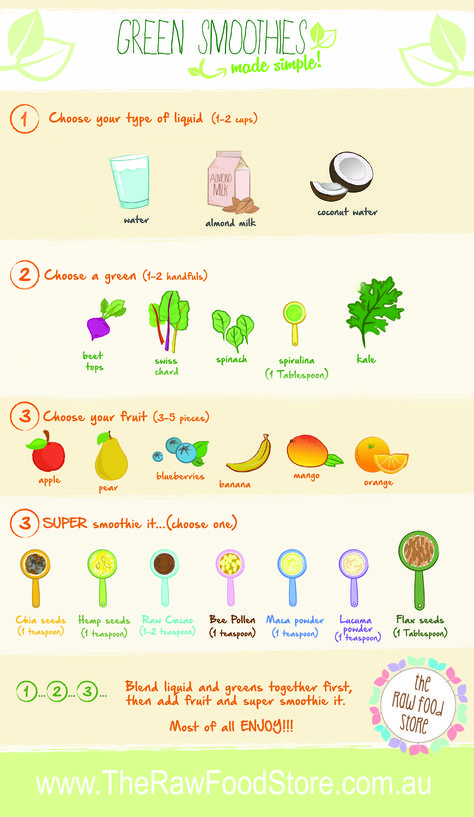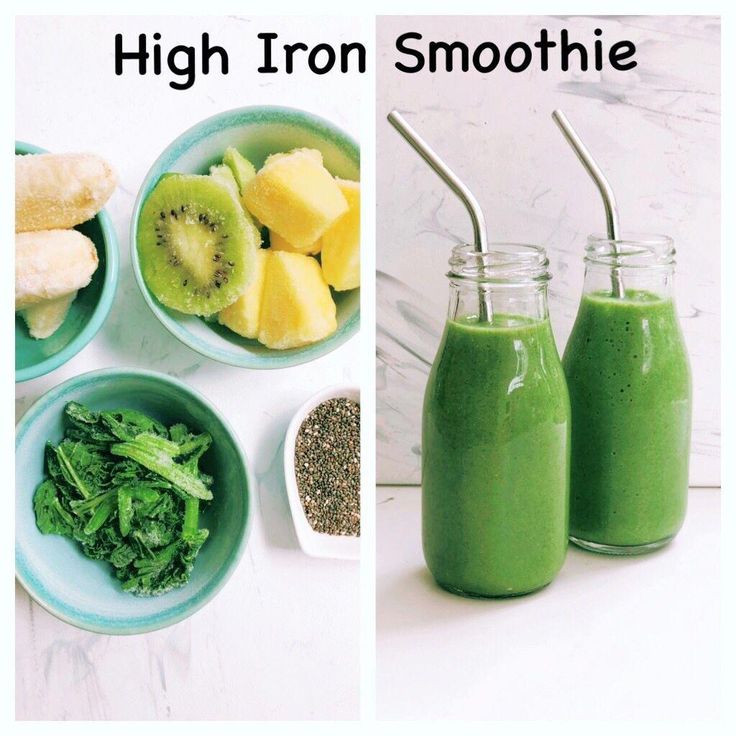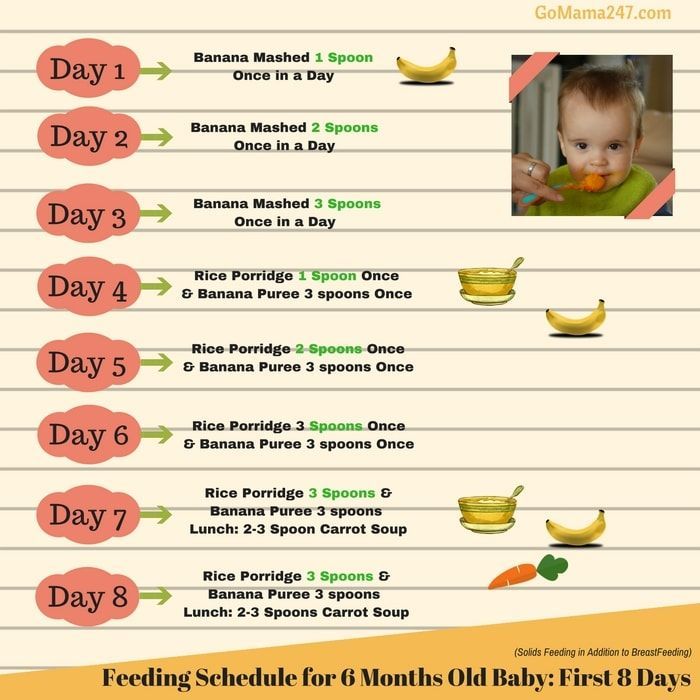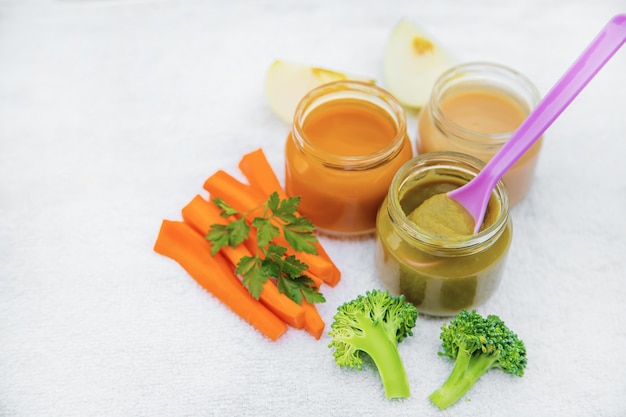When to feed baby 3 solid meals a day
Your baby's first solid foods
When to start introducing solid foods
Introducing your baby to solid foods, sometimes called complementary feeding or weaning, should start when your baby is around 6 months old.
At the beginning, how much your baby eats is less important than getting them used to the idea of eating.
They'll still be getting most of their energy and nutrients from breast milk or first infant formula.
Giving your baby a variety of foods, alongside breast or formula milk, from around 6 months of age will help set your child up for a lifetime of healthier eating.
Gradually, you'll be able to increase the amount and variety of food your baby eats until they can eat the same foods as the rest of the family, in smaller portions.
If your baby was born prematurely, ask your health visitor or GP for advice on when to start introducing solid foods.
Why wait until around 6 months to introduce solids?
It’s a good idea to wait until around 6 months before introducing solid foods because:
- breast milk or first infant formula provide the energy and nutrients your baby needs until they're around 6 months old (with the exception of vitamin D in some cases)
- if you're breastfeeding, feeding only breast milk up to around 6 months of age will help protect your baby against illness and infections
- waiting until around 6 months gives your baby time to develop so they can cope fully with solid foods – this includes solid foods made into purées, cereals and baby rice added to milk
- your baby will be more able to feed themselves
- your baby will be better at moving food around their mouth, chewing and swallowing it – this may mean they'll be able to progress to a range of tastes and textures (such as mashed, lumpy and finger foods) more quickly, and may not need smooth, blended foods at all
Signs your baby is ready for solid foods
There are 3 clear signs which, when they appear together from around 6 months of age, show your baby is ready for their first solid foods alongside breast milk or first infant formula.
They'll be able to:
- stay in a sitting position and hold their head steady
- co-ordinate their eyes, hands and mouth so they can look at the food, pick it up and put it in their mouth by themselves
- swallow food (rather than spit it back out)
The following behaviours can be mistaken by parents as signs that their baby is ready for solid foods:
- chewing their fists
- waking up in the night (more than usual)
- wanting extra milk feeds
These are all normal behaviours for babies and not necessarily a sign that they're hungry or ready to start solid food.
Starting solid foods will not make your baby any more likely to sleep through the night. Sometimes a little extra milk will help until they're ready for solid foods.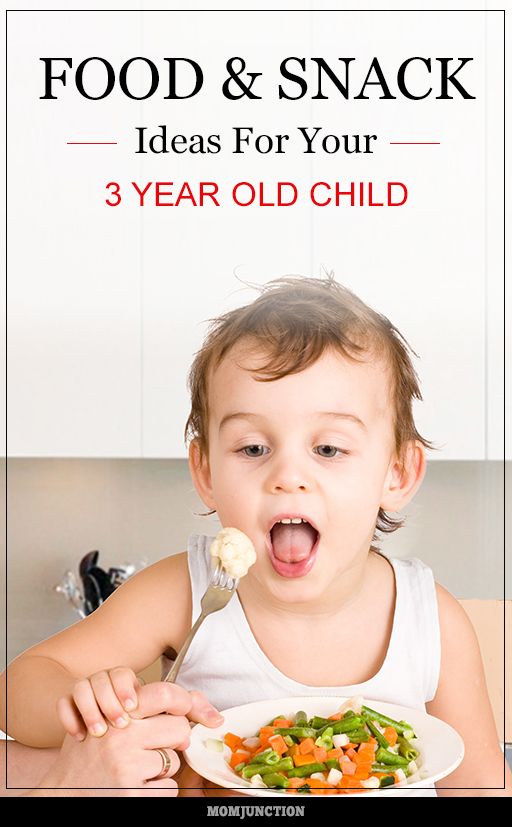
Get tips to help your baby sleep well
How to start solid foods
In the beginning your baby will only need a small amount of food before their usual milk feed.
Do not worry about how much they eat. The most important thing is getting them used to new tastes and textures, and learning how to move solid foods around their mouths and how to swallow them.
They'll still be getting most of their energy and nutrients from breast milk or infant formula.
There are some foods to avoid giving to your baby. For example, do not add sugar or salt (including stock cubes and gravy) to your baby's food or cooking water.
Babies should not eat salty foods as it's not good for their kidneys, and sugar can cause tooth decay.
Tips to get your baby off to a good start with solid foods:
- Eating is a whole new skill.
 Some babies learn to accept new foods and textures more quickly than others. Keep trying, and give your baby lots of encouragement and praise.
Some babies learn to accept new foods and textures more quickly than others. Keep trying, and give your baby lots of encouragement and praise. - Allow plenty of time, especially at first.
- Go at your baby's pace and let them show you when they're hungry or full. Stop when your baby shows signs that they've had enough. This could be firmly closing their mouth or turning their head away. If you're using a spoon, wait for your baby to open their mouth before you offer the food. Do not force your baby to eat. Wait until the next time if they're not interested this time.
- Be patient and keep offering a variety of foods, even the ones they do not seem to like. It may take 10 tries or more for your baby to get used to new foods, flavours and textures. There will be days when they eat more, some when they eat less, and then days when they reject everything. Do not worry, this is perfectly normal.
- Let your baby enjoy touching and holding the food.
 Allow them to feed themselves, using their fingers, as soon as they show an interest. If you're using a spoon, your baby may like to hold it or another spoon to try feeding themselves.
Allow them to feed themselves, using their fingers, as soon as they show an interest. If you're using a spoon, your baby may like to hold it or another spoon to try feeding themselves. - Keep distractions to a minimum during mealtimes and avoid sitting your baby in front of the television, phone or tablet.
- Show them how you eat. Babies copy their parents and other children. Sit down together for family mealtimes as much as possible.
Texture progression
Once you've started introducing solid foods from around 6 months of age, try to move your baby on from puréed or blended foods to mashed, lumpy or finger foods as soon as they can manage them.
This helps them learn how to chew, move solid food around their mouth and swallow.
Some babies like to start with mashed, lumpy or finger foods.
Other babies need a little longer to get used to new textures, so may prefer smooth or blended foods on a spoon at first.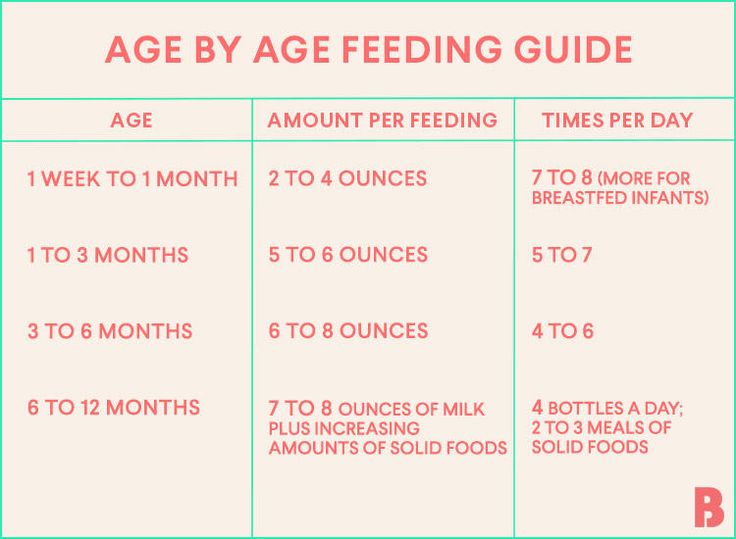
Just keep offering them lumpy textures and they'll eventually get used to it.
Safety and hygiene
When introducing your baby to solid foods, it's important to take extra care to not put them at risk.
Key food safety and hygiene advice:
- always wash your hands before preparing food and keep surfaces clean
- cool hot food and test it before giving it to your baby
- wash and peel fruit and raw vegetables
- avoid hard foods like whole nuts, or raw carrot or apple
- remove hard pips and stones from fruits, and bones from meat or fish
- cut small, round foods, like grapes and cherry tomatoes, into small pieces
- eggs produced under the British Lion Code of Practice (stamped with the red lion) are considered very low risk for salmonella and safe for babies to eat partially cooked
Always stay with your baby when they're eating in case they start to choke.
Choking is different from gagging. Your baby may gag when you introduce solid foods.
This is because they're learning how to deal with solid foods and regulate the amount of food they can manage to chew and swallow at one time.
If your baby is gagging:
- their eyes may water
- they might push their tongue forward (or out of their mouth)
- they might retch to bring the food forward in their mouth or vomit
Equipment checklist
- High chair. Your baby needs to be sitting safely in an upright position (so they can swallow properly). Always use a securely fitted safety harness in a high chair. Never leave babies unattended on raised surfaces.
- Plastic or pelican bibs. It's going to be messy at first!
- Soft weaning spoons are gentler on your baby's gums.
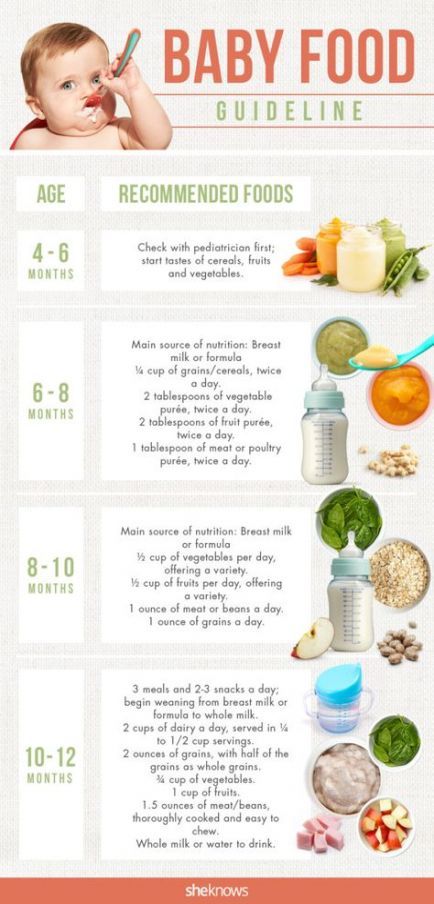
- Small plastic bowl. You may find it useful to get a special weaning bowl with a suction base to keep the bowl in place.
- First cup. Introduce a cup from around 6 months and offer sips of water with meals. Using an open cup or a free-flow cup without a valve will help your baby learn to sip and is better for their teeth.
- A messy mat or newspaper sheets under the high chair to catch most of the mess.
- Plastic containers and ice cube trays can be helpful for batch cooking and freezing small portions.
Find out more:
- tips to help your baby enjoy new foods
- children's food: safety and hygiene
- foods to avoid giving babies and young children
- how to stop a child from choking
- baby and toddler safety
Feeding your baby: from 0 to 6 months
Breast milk is the best food your baby can have during their first 6 months of life.
It's free, always available and at the perfect temperature, and is tailor-made for your baby.
First infant formula is the only suitable alternative if you do not breastfeed or choose to supplement breast milk.
Other milks or milk substitutes, including cows' milk, should not be introduced as a main drink until 12 months of age.
"Follow-on" formula is not suitable for babies under 6 months, and you do not need to introduce it after 6 months.
Babies do not need baby rice to help them move to solid foods or sleep better.
When using a bottle, do not put anything (such as sugar or cereals) in it other than breast milk or infant formula.
Vitamins for babies
It's recommended that breastfed babies are given a daily supplement containing 8.5 to 10 micrograms (µg) of vitamin D from birth, whether or not you're taking a supplement containing vitamin D yourself.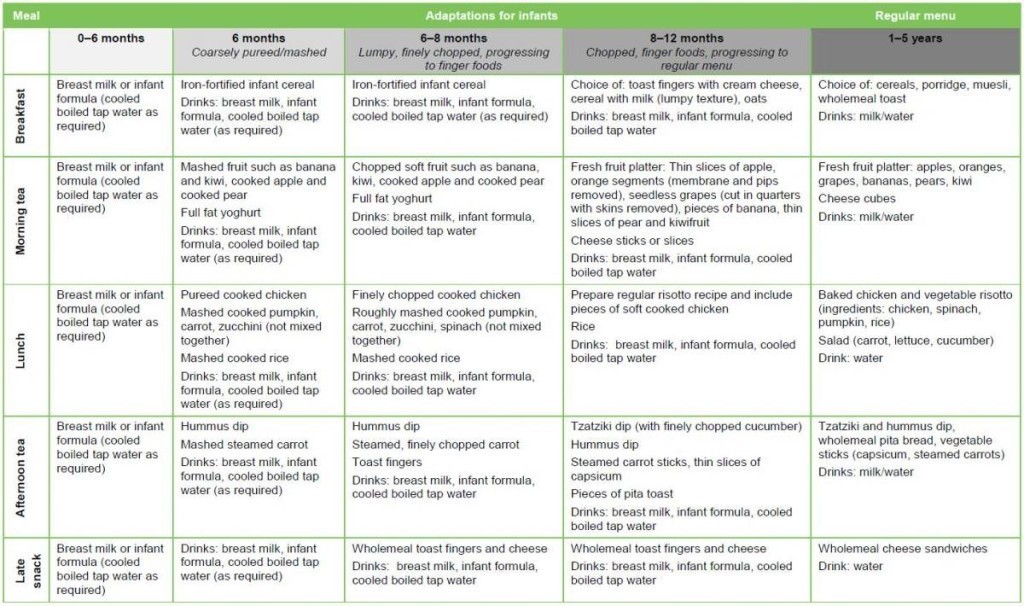
Babies having 500mls (about a pint) or more of formula a day should not be given vitamin supplements.
This is because formula is fortified with vitamin D and other nutrients.
All children aged 6 months to 5 years should be given vitamin supplements containing vitamins A, C and D every day.
Find out more:
- benefits of breastfeeding
- how to make up baby formula
- vitamins for children
Feeding your baby: from around 6 months
When they first start having solid foods, babies do not need 3 meals a day. Babies have tiny tummies, so start by offering them small amounts of food (just a few pieces, or teaspoons of food).
Pick a time that suits you both, when you do not feel rushed and your baby is not too tired.
Start offering them food before their usual milk feed as they might not be interested if they're full, but do not wait until your baby is too hungry.
Allow plenty of time and let your baby go at their own pace.
Keep offering different foods, even foods your baby has already rejected.
It can take 10 tries or more before your baby will accept a new food or texture, particularly as they get older.
Your baby will still be getting most of their energy and nutrients from breast milk or first infant formula.
Breast milk or infant formula should be their main drink during the first year. Do not give them whole cows' (or goats' or sheep's) milk as a drink until they're 1 year old.
You can continue breastfeeding for as long as you both want.
Introduce a cup from around 6 months and offer sips of water with meals.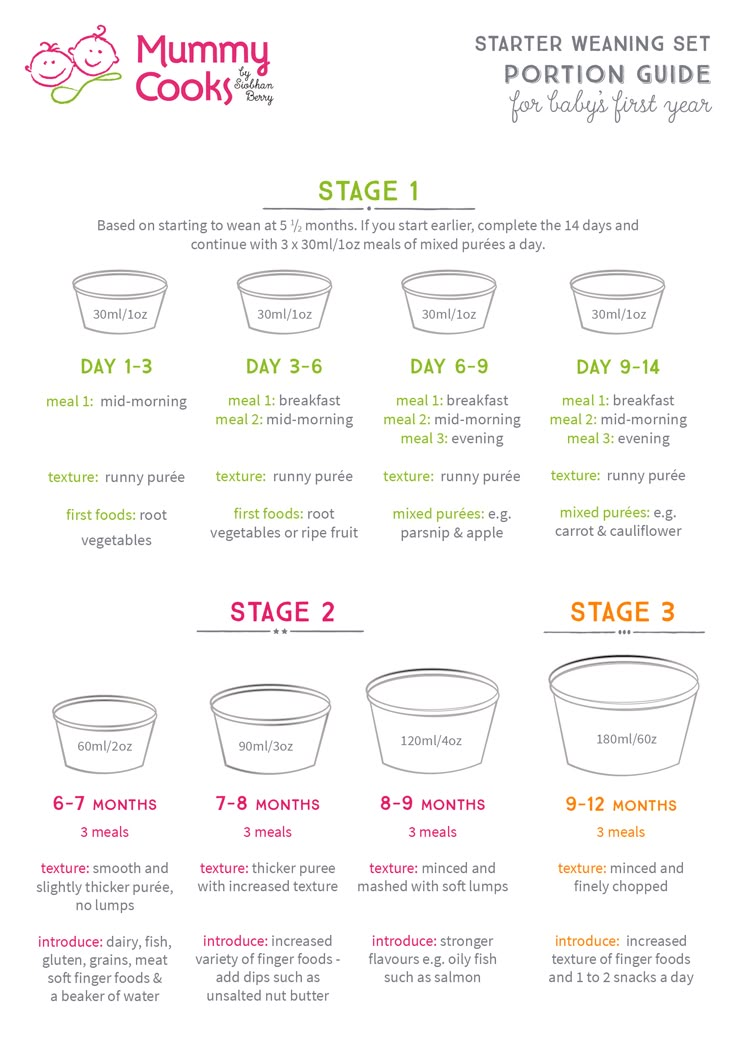 Using an open cup or a free-flow cup without a valve will help your baby learn to sip and is better for their teeth.
Using an open cup or a free-flow cup without a valve will help your baby learn to sip and is better for their teeth.
First foods
You might want to start with single vegetables and fruits.
Try mashed or soft cooked sticks of parsnip, broccoli, potato, yam, sweet potato, carrot, apple or pear.
Include vegetables that are not sweet, such as broccoli, cauliflower and spinach.
This will help your baby get used to a range of flavours (rather than just the sweeter ones, like carrots and sweet potato) and might help prevent them being fussy eaters as they grow up.
Make sure any cooked food has cooled right down before offering it to your baby.
Foods containing allergens (such as peanuts, hens' eggs, gluten and fish) can be introduced from around 6 months of age, 1 at a time and in small amounts so you can spot any reaction.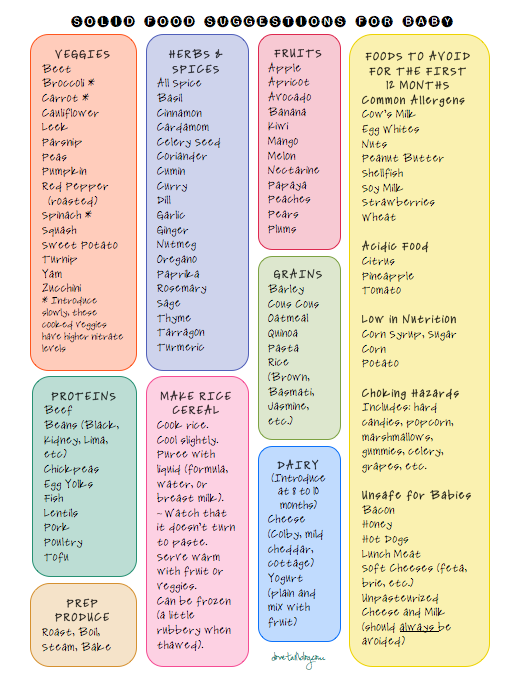
Cows' milk can be used in cooking or mixed with food from around 6 months of age, but should not be given as a drink until your baby is 1 year old.
Full-fat dairy products, such as pasteurised cheese and plain yoghurt or fromage frais, can be given from around 6 months of age. Choose products with no added sugar.
Remember, babies do not need salt or sugar added to their food (or cooking water).
Finger foods
As soon as your baby starts solid foods, encourage them to be involved in mealtimes and have fun touching, holding and exploring food.
Let them feed themselves with their fingers when they want to. This helps develop fine motor skills and hand-eye co-ordination.
Your baby can show you how much they want to eat, and it gets them familiar with different types and textures of food.
Offering your baby finger foods at each meal is a good way to help them learn to self-feed.
Finger food is food that's cut up into pieces big enough for your baby to hold in their fist with a bit sticking out.
Pieces about the size of your own finger work well.
Start off with finger foods that break up easily in their mouth and are long enough for them to grip.
Avoid hard food, such as whole nuts or raw carrots and apples, to reduce the risk of choking.
Examples of finger foods include:
- soft cooked vegetables, such as carrot, broccoli, cauliflower, parsnip, butternut squash
- fruit (soft, or cooked without adding sugar), such as apple, pear, peach, melon, banana
- grabbable bits of avocado
- cooked starchy foods, such as potato, sweet potato, cassava, pasta, noodles, chapatti, rice
- pulses, such as beans and lentils
- fish without bones
- hardboiled eggs
- meat without bones, such as chicken and lamb
- sticks of pasteurised full-fat hard cheese (choose lower salt options)
Baby-led weaning
Baby-led weaning means giving your baby only finger foods and letting them feed themselves from the start instead of feeding them puréed or mashed food on a spoon.
Some parents prefer baby-led weaning to spoon feeding, while others do a combination of both.
There's no right or wrong way. The most important thing is that your baby eats a wide variety of food and gets all the nutrients they need.
There's no more risk of choking when a baby feeds themselves than when they're fed with a spoon.
Find out more:
- help your baby enjoy new foods
- drinks and cups for babies and young children
- food allergies in babies and young children
- foods to avoid giving babies and young children
Feeding your baby: from 7 to 9 months
From about 7 months, your baby will gradually move towards eating 3 meals a day (breakfast, lunch and tea), in addition to their usual milk feeds, which may be around 4 a day (for example, on waking, after lunch, after tea and before bed).
As your baby eats more solid foods, they may want less milk at each feed or even drop a milk feed altogether.
If you're breastfeeding, your baby will adapt their feeds according to how much food they're having.
As a guide, formula-fed babies may need around 600ml of milk a day.
Gradually increase the amount and variety of food your baby is offered to ensure they get the energy and nutrients they need.
Try to include food that contains iron, such as meat, fish, fortified breakfast cereals, dark green vegetables, beans and lentils, at each meal.
Your baby's diet should consist of a variety of the following:
- fruit and vegetables, including ones with bitter flavours, such as broccoli, cauliflower, spinach and cabbage
- potatoes, bread, rice, pasta and other starchy foods
- beans, pulses, fish, eggs, meat and other non-dairy sources of protein
- pasteurised full-fat dairy products, such as plain yoghurt and cheese (choose lower salt options)
As your baby becomes a more confident eater, remember to offer them more mashed, lumpy and finger foods.
Providing finger foods as part of each meal helps encourage infants to feed themselves, develop hand and eye co-ordination, and learn to bite off, chew and swallow pieces of soft food.
Remember, babies do not need salt or sugar added to their food (or cooking water).
Feeding your baby: from 10 to 12 months
From about 10 months, your baby should now be having 3 meals a day (breakfast, lunch and tea), in addition to their usual milk feeds.
Around this age, your baby may have about 3 milk feeds a day (for instance, after breakfast, after lunch and before bed).
Breastfed babies will adapt their milk consumption as their food intake changes.
As a guide, babies fed infant formula will drink about 400ml daily.
Remember that formula-fed babies should take a vitamin D supplement if they're having less than 500ml of formula a day.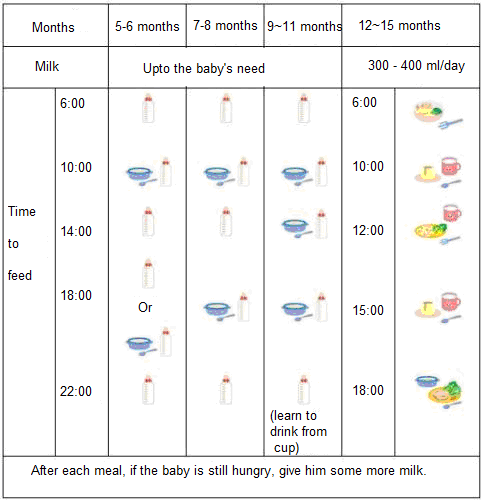
All breastfed babies should take a vitamin D supplement.
By now, your baby should be enjoying a wide range of tastes and textures.
They should be able to manage a wider range of finger foods, and be able to pick up small pieces of food and move them to their mouth. They'll use a cup with more confidence.
Lunches and teas can include a main course, and a fruit or unsweetened dairy-based dessert, to move eating patterns closer to those of children over 1 year.
As your baby grows, eating together as a family encourages them to develop good eating habits.
Remember, babies do not need salt or sugar added to their food (or cooking water).
Feeding your baby: from 12 months
From 12 months, your child will be eating 3 meals a day containing a variety of different foods, including:
- a minimum of 4 servings a day of starchy food, such as potatoes, bread and rice
- a minimum of 4 servings a day of fruit and vegetables
- a minimum of 350ml milk or 2 servings of dairy products (or alternatives)
- a minimum of 1 serving a day of protein from animal sources (meat, fish and eggs) or 2 from vegetable sources (dhal, beans, chickpeas and lentils)
Your child may also need 2 healthy snacks in between meals.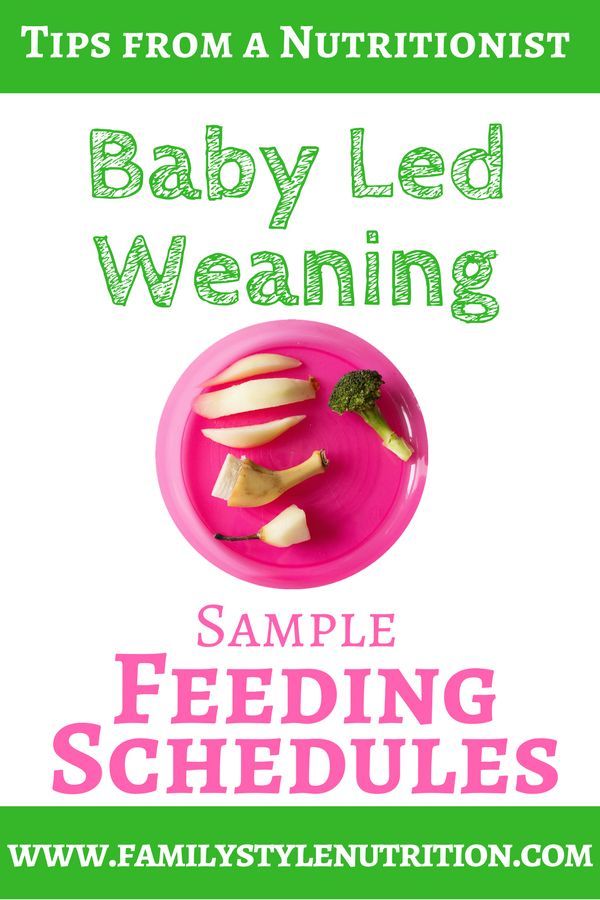
Go for things like:
- fresh fruits, such as apple, banana or small pieces of soft, ripe, peeled pear or peach
- cooked or raw vegetable, such as broccoli florets, carrot sticks or cucumber sticks
- pasteurised plain full-fat yoghurt
- sticks of cheese (choose a lower salt option)
- toast, pitta or chapatti fingers
- unsalted and unsweetened rice or corn cakes
The World Health Organization recommends that all babies are breastfed for up to 2 years or longer.
You can keep breastfeeding for as long as it suits you both, but your child will need less breast milk to make room for more foods.
Once your child is 12 months old, infant formula is not needed and toddler milks, growing-up milks and goodnight milks are also unnecessary.
Your baby can now drink whole cows' milk. Choose full-fat dairy products, as children under 2 years old need the vitamins and extra energy found in them.
From 2 years old, if they're a good eater and growing well, they can have semi-skimmed milk.
From 5 years old, 1% fat and skimmed milk is OK.
You can give your child unsweetened calcium-fortified milk alternatives, such as soya, oat or almond drinks, from the age of 1 as part of a healthy, balanced diet.
Children under 5 years old should not be given rice drinks because of the levels of arsenic in these products.
Find out more:
- what to feed young children
- foods to avoid giving babies and young children
- drinks and cups for babies and young children
- vitamins for children
Get Start4Life pregnancy and baby emails
For information and advice you can trust, sign up for weekly Start4Life pregnancy and baby emails.
When Do I Move My Baby Onto Three Meals a Day?
One question I get asked more than daily is the following “When should I move my baby from one, to two and three meals a day”.
I also see TONNES of different answers to this question on social media, online and in weaning books too. So I thought I would try and address the answer, from my own experience, knowledge and opinions on here.
It’s no wonder really that families are confused about this. But ultimately, there really is no right or wrong answer. Babies move through weaning at such different paces, some take to food really quickly and may even start reducing their milk intakes earlier on and be on three meals after a few weeks or so of solids. Others are much more gradual, they explore foods slower and may take a while to move from 1-2-3 meals a day.
So the answer, although not black and white, is really to go at your baby’s own pace with meal frequency.
Helpfully, the NHS recommend the following:
“Your baby will gradually move towards eating 3 meals a day (breakfast, lunch and tea), in addition to their usual milk feeds, which may be around 4 a day (for example, on waking, after lunch, after tea and before bed)” in their 7-9 month age section, which is a good, rough guide of a baby’s progress through meals.
Starting on Meal One
Ultimately in the beginning it’s about simply offering one meal a day to baby and starting to build in a structure and a routine around when your baby has “meals”. Going straight into 3 meals may be a bit much for a baby, whose digestive system needs a little time to note the change from a milk only diet and when they only really need small amounts and tiny tastes of food.
A gradual progression through the meals is key and this can also help them become familiar with the concept of “mealtimes” which I really find encourages babies to accept solid foods more readily.
Once you find your baby is happy with their single meal each day, they are swallowing a fair bit at each mealtime (sometimes this takes a little longer with BLW babies) and really getting to grips eating solids at mealtimes, it might be time to start building in another meal each day. Check you’re ready too as a parent, as this is important for yours and their confidence too.
This might happen one or two weeks after their first solid tastes, or it might be more like 2 months – that’s OK. However, ideally, by around 9 months of age baby will be eating 3 meals a day – such as breakfast, lunch and dinner with their usual milk in-between. Again, this is just a guide and depends hugely on your baby’s individual circumstances, so don’t worry if you’re not quite there yet.
What about milk intakes?
Milk often causes a lot of controversy around this time too.
Initially offer your little one the SAME amount of milk that you did before weaning began and try (if bottle feeding) to get into a bit of a routine around meals and milk feeds. It can help to leave a gap after a milk feed of roughly an hour to allow baby to build up an appetite, or try offering solid foods BEFORE a milk feed. If you’re formula feeding, responsive feeding is recommended (I’ll be blogging about this soon along with a fab health visitor I’ve been working with) which essentially means responding to your baby’s AND your body’s needs with regards to when they/you need to feed them.
At the start of weaning you might notice…
A – Baby takes to food WELL and seems to quickly drop their milk intakes
Or
B – Baby is less keen on food and seems to prefer having their milk feeds
These scenarios are both very common. In A, keep offering the same amount of milk to baby as they may come back to it once they’ve regulated their appetite around their new solid feeds. Additionally, you can add your expressed milk, your formula milk or even full fat cow’s milk (as long as baby isn’t allergic to it) into baby’s food as a top up on the milk.
In scenario B it’s important that baby still learns that food is part of their diet alongside milk. It’s not true that food before one is JUST for fun, food is an important part of a baby’s diet from 6 months from a nutrition and a learning standpoint. Try to establish a bit of a routine around solids, eat with your baby as much as possible, offer food in different ways (some mashed and some finger foods can help this way to allow baby the independence around how they want to eat initially) and keep up with a variety of options to.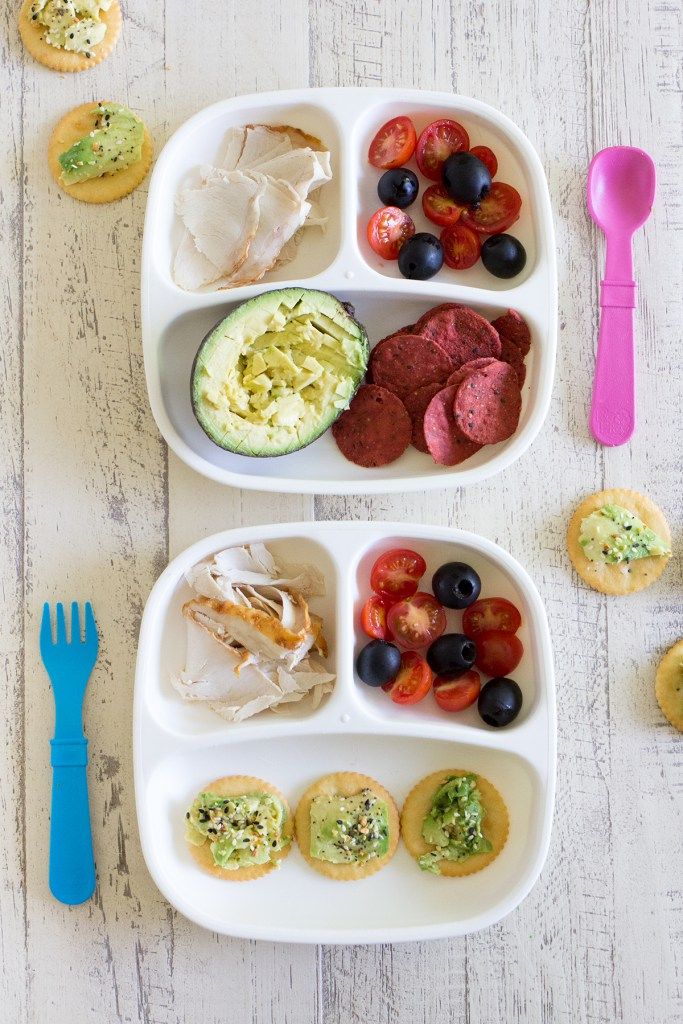 Sometimes it takes babies a little longer to get there and that’s OK.
Sometimes it takes babies a little longer to get there and that’s OK.
How much milk?
The NHS recommend that around 7 months of age babies should be having roughly 600mls of formula milk, which drops to around 400mls by 10 months of age – that’s a good guide of how much your baby should be taking and may coincide with them gradually eating larger portions and an increased number of meals too.
Check out my blog on Milk Recommendations for Babies and Toddlers for more info on this.
Summary:
Ultimately, go at your baby’s own pace. If they seem ready and keen to have more solids, go with the flow. If they are a little reluctant, give them time and practice lots of role modelling and making mealtimes enjoyable too.
Russian Union of Pediatricians
Introduction of complementary foods
How to introduce complementary foods correctly is one of the most pressing issues that concern parents.
In the first months of life, the main food for the baby is breast milk or an adapted milk formula, however, as the child grows and develops, this becomes insufficient and it is necessary to think about the introduction of complementary foods.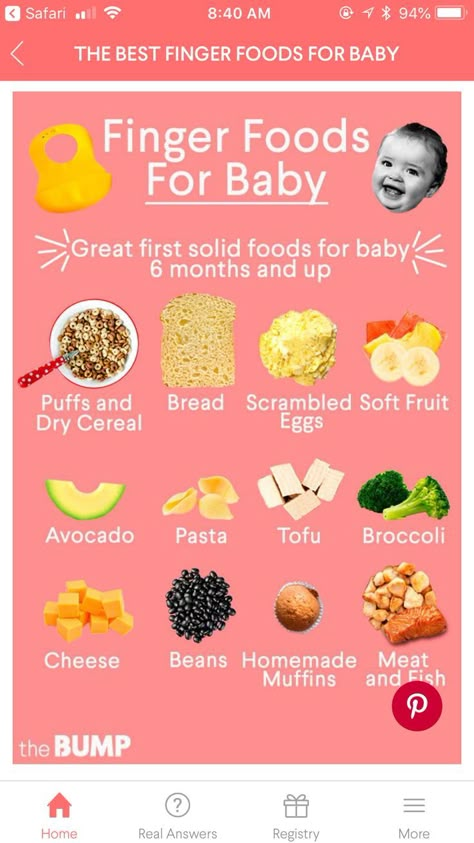
Your baby is over 4 months old. He has noticeably grown up, become more active, is interested in objects that fall into his field of vision, carefully examines them and reaches for them. The child's emotional reactions have become much richer: he smiles happily at all people, makes various sounds. Perhaps you notice that the child looks into your plate with interest, closely monitors what and how you eat, does this mean that it is time to introduce complementary foods? And where is the best place to start? Let's figure it out!
When should complementary foods be started?
According to the Program for optimizing the feeding of infants in the first year of life in the Russian Federation (2019), the recommended age for the introduction of complementary foods is in the range from 4 to 6 months.
The following points will help determine the readiness of the baby for the introduction of complementary foods:
1. Food interest - you can check its presence as follows: during your meal, give the baby an empty spoon or fork, and if he plays with it, licks it, then there is no food interest yet; but if the child is dissatisfied with the fact that the spoon is empty, food interest has probably appeared.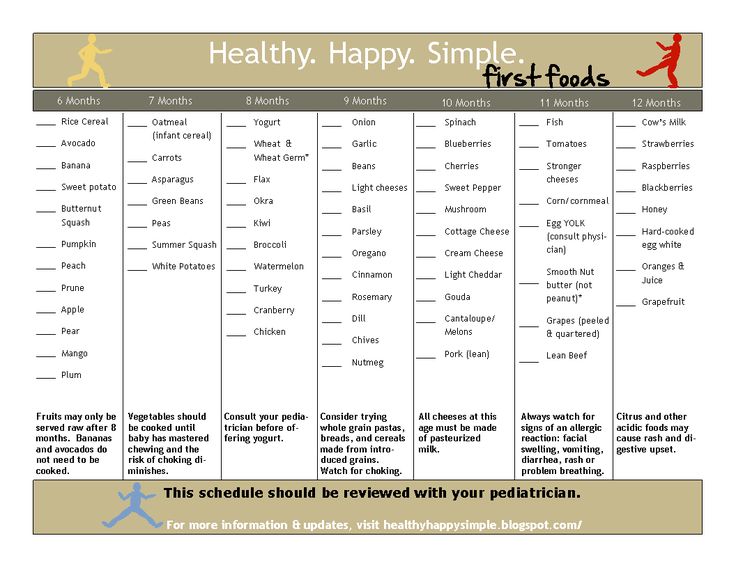 “But how does a child understand that there should be food in a spoon?” Parents often ask. The answer is quite simple: take your baby to the table with you so that he can see how you eat!
“But how does a child understand that there should be food in a spoon?” Parents often ask. The answer is quite simple: take your baby to the table with you so that he can see how you eat!
2. The child can sit alone or with support. It is unacceptable to feed the child lying down, because he may choke.
3. Extinction of the “pushing out” reflex - when the baby pushes out of the mouth both the offered food and the pacifier, etc.
Why is it not recommended to introduce complementary foods before 4 and after 6 months of life?
Before 4 months of life, the baby is not yet ready to digest food other than breast milk or infant formula. By this age, a number of digestive enzymes mature, a sufficient level of local immunity is formed, which reduces the risk of developing allergic reactions, the child acquires the ability to swallow semi-liquid and thicker food, which is due to the extinction of the “spoon ejection reflex”. The introduction of complementary foods after 6 months can cause a pronounced deficiency of micronutrients (iron, zinc, etc.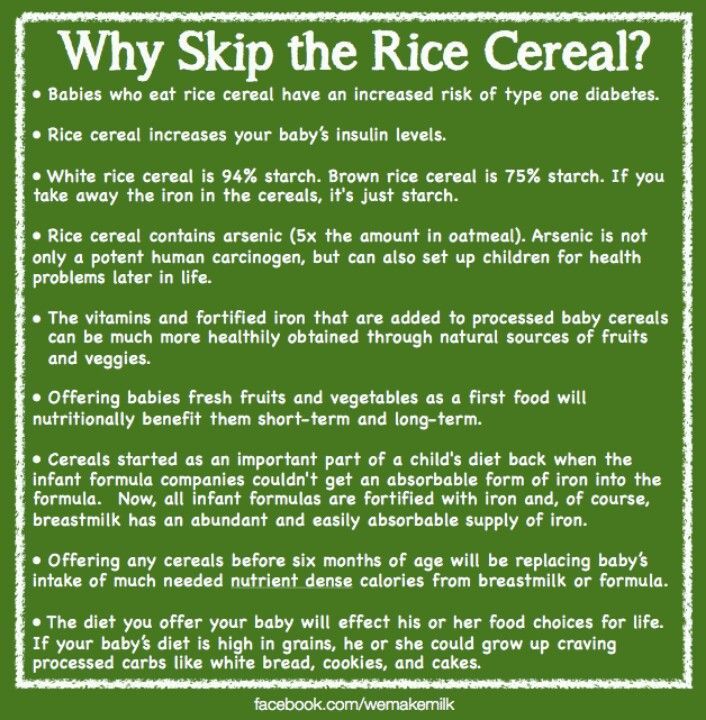 ) and lead to a delay in the formation of chewing skills for thick foods. Too late the introduction of a variety of products increases the risk of allergic reactions. Remember that the timing of the introduction of complementary foods is set individually, taking into account the readiness of the child to accept new foods.
) and lead to a delay in the formation of chewing skills for thick foods. Too late the introduction of a variety of products increases the risk of allergic reactions. Remember that the timing of the introduction of complementary foods is set individually, taking into account the readiness of the child to accept new foods.
Complementary feeding guidelines:
1. introduce a new product in the first half of the day to track possible reactions to it;
2. cereals, vegetable / fruit / meat purees should be introduced, starting with monocomponent ones, gradually adding other products of this group;
3. start giving a new product with 1/2 teaspoon, gradually increasing the volume to the age norm within a week;
4. It is not recommended to introduce new products during acute infectious diseases or at some special moments (moving to another apartment, leaving the city, on vacation, illness of parents, etc.).
What is the best way to start complementary foods?
The first complementary food can be anything. Often parents worry that if the child first tries the fruit, then because of its sweet taste, he will refuse other foods. We hasten to reassure you: breast milk is also sweet, so babies may like sweet fruits / berries more, but this does not mean at all that he will refuse vegetables or cereal. Traditionally, they begin to introduce complementary foods in the form of mashed potatoes, but if the child shows interest in “pieces”, then, observing the safety rules, you can give them. Also, along with the introduction of complementary foods, you can offer the child water.
Often parents worry that if the child first tries the fruit, then because of its sweet taste, he will refuse other foods. We hasten to reassure you: breast milk is also sweet, so babies may like sweet fruits / berries more, but this does not mean at all that he will refuse vegetables or cereal. Traditionally, they begin to introduce complementary foods in the form of mashed potatoes, but if the child shows interest in “pieces”, then, observing the safety rules, you can give them. Also, along with the introduction of complementary foods, you can offer the child water.
With the start of the introduction of complementary foods, the child is gradually transferred to a 5-time feeding regimen. If the baby shows that he is full and no longer wants to eat (for example, leaning back or turning away from food), then you should not continue to force him to feed, because this can lead to eating disorders in the future. Also, do not force the child to eat as much as possible before bedtime in the hope that he will not wake up for nightly feedings.
Traditionally, in our country, complementary foods begin with vegetables or cereals.
Vegetables: zucchini, broccoli, cauliflower, pumpkin, etc. If the child did not like the dish, for example, broccoli, do not give up on your plan and continue to offer this vegetable in small quantities daily, you can even not once, but 2-3 times, and after a while (7-14 days) the baby will get used to the new taste. This diversifies his diet, will help form the right taste habits in the child.
As for cereals, it is worth starting with dairy-free gluten-free ones - buckwheat, corn, rice. You can use commercial baby food porridge, which is enriched primarily with iron. In addition, such porridge is already ready to eat, you just need to dilute it with water, which will save you a lot of time.
It is also recommended to add oil to food, for example, vegetable puree to vegetable puree, and butter to porridge.
Of meat products, lean meats, such as mashed turkey or rabbit, are most preferred to start complementary foods. Meat puree contains iron, which is easily absorbed, and adding meat to vegetables improves the absorption of this micronutrient from them. Subsequently, the daily use of children's enriched porridge and mashed meat allows you to meet the needs of babies for iron, zinc and other micronutrients.
Meat puree contains iron, which is easily absorbed, and adding meat to vegetables improves the absorption of this micronutrient from them. Subsequently, the daily use of children's enriched porridge and mashed meat allows you to meet the needs of babies for iron, zinc and other micronutrients.
When introducing fruit purees (apple, pear, peach, prunes, etc.) into your baby's diet, you should pay special attention to the composition of the product - it is important that it does not contain added sugar.
Fish is a source of easily digestible protein and contains a large amount of polyunsaturated fatty acids, including the omega-3 class, as well as vitamins B2, B12, and minerals. Preference should be given to oceanic fish, preferably white (cod, hake, pollock, sea bass, etc.), salmon can be recommended from red, and pike perch from river.
Fermented milk products are prepared using a special starter culture that breaks down milk protein, so that the baby can get an indispensable set of amino acids in a well-available form. Some foods have added prebiotics, certain vitamins and minerals. Their regular use favorably affects the functioning of the intestines, increases appetite and the absorption of micronutrients.
Some foods have added prebiotics, certain vitamins and minerals. Their regular use favorably affects the functioning of the intestines, increases appetite and the absorption of micronutrients.
Recommendations and timing of the introduction of complementary foods for children at risk of developing food allergies and suffering from food allergies are the same as for healthy children. Delayed introduction of highly allergenic foods has previously been recommended to prevent the development of allergic diseases in children at risk. There is now evidence that this practice may lead to an increase rather than a decrease in the incidence of food allergies. The most common highly allergenic foods include cow's milk, chicken eggs, soybeans, wheat, peanuts, tree nuts, shellfish and fish. If a child has a high risk of developing allergies or an existing allergic disease, it is recommended to consult a pediatrician, an allergist-immunologist before introducing highly allergenic products.
By the age of 8 months, when all the main food groups have already been introduced and your baby is improving his skills to eat on his own, special attention should be paid to the diversity of the composition of dishes and the change in food consistency - from puree to finely and coarsely ground. Soft foods cut into small pieces (fruits, vegetables, meat, etc.) are perfect for a little gourmet, which diversifies his diet and will contribute to the formation of chewing skills.
By 9-12 months, most babies have the dexterity to drink from a cup (holding with both hands) and to eat foods prepared for other family members. This behavior needs to be encouraged, but combined with regular feeding to meet energy and nutrient requirements.
It is advisable to use industrial products that are designed specifically for young children after a year.
What should not be given to the baby?
It is not recommended to add salt or sugar to food to enhance the taste.
Drinks that should be avoided include fruit juices, whole cow and goat milk (whole milk is not recommended for children under one year old, and even longer, due to a high risk of developing iron deficiency and increased kidney stress), sweet fruit drinks, compotes and carbonated drinks.
Also, some foods should be excluded from the diet of infants: solid round foods (for example, nuts, grapes, raw carrots, raisins, peas, etc.), due to the fact that the child can choke on them.
It is not recommended to eat products with added sugar, for example, confectionery (marshmallow, marshmallow, marmalade, jam, jam, cookies, waffles, etc.), etc.
You should not give your child the meat of large predatory fish (shark, bigeye tuna, king mackerel, swordfish): these types of fish accumulate more harmful substances than others.
It is forbidden to give honey to children under one year old due to the fact that it may contain spores of Clostridium botulinum bacteria, which in the still immature digestive system of babies are able to multiply, produce toxins directly inside the intestines and, thus, cause infant botulism, which can be fatal.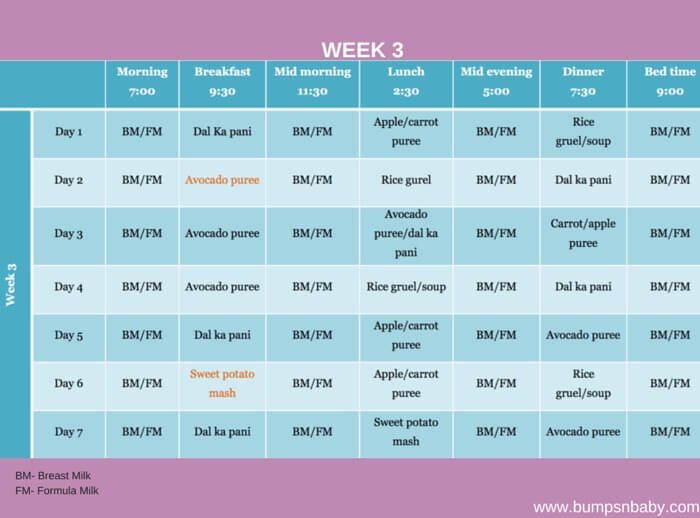 outcome.
outcome.
Do not give babies raw meat, fish, eggs, caviar, salted fish, soft pickled cheeses because of the risk of intestinal infections.
If you follow all these simple rules, your baby will grow up healthy and happy!
Diets for different ages
References:
1. Methodological recommendations. The program for optimizing the feeding of children in the first year of life in the Russian Federation. [Internet]. - M.: Union of Pediatricians of Russia, 2019. [Methodicheskie rekomendaczii. Programma optimizaczii vskarmlivaniya detej pervogo goda zhizni v Rossijskoj Federaczii. [Internet]. – Moscow: Soyuz pediatrov Rossii, 2019.(In Russ.).] Available: http://www.pediatr-russia.ru/information/dokumenty/other-docs/nacprog1year_2019.pdf Link active as of 20.04.2020
2. Duryea T.K. Introducing solid foods and vitamin and mineral supplementation during infancy. In: Post T, ed. UpToDate . Waltham, Mass.: UpToDate; 2020. www.uptodate.com. Accessed April 20, 2020.
www.uptodate.com. Accessed April 20, 2020.
3.Fleischer D.M. Introducing highly allergenic foods to infants and children. In: Post T, ed. UpToDate . Waltham, Mass.: UpToDate; 2020. www.uptodate.com. Accessed April 20, 2020.
Seven Months Menu
Contents
- When breastfeeding, latch your baby to your breast every 3-4 hours.
- If you give your baby expressed breast milk, he needs approximately 710 grams per day. With 5-6 meals a day, this is about 120 to 200 grams of milk per meal.
- If the baby is formula-fed (FW), he needs 170 to 230 grams of formula up to 4 times a day, provided that 2 more feedings replace complementary foods. To find out how much mixture you need, be guided by the instructions on the package, the recommendations of the pediatrician.
- From the age of 6 months, only mother's milk or adapted infant formula is not enough for a baby - he needs a variety of complementary foods.
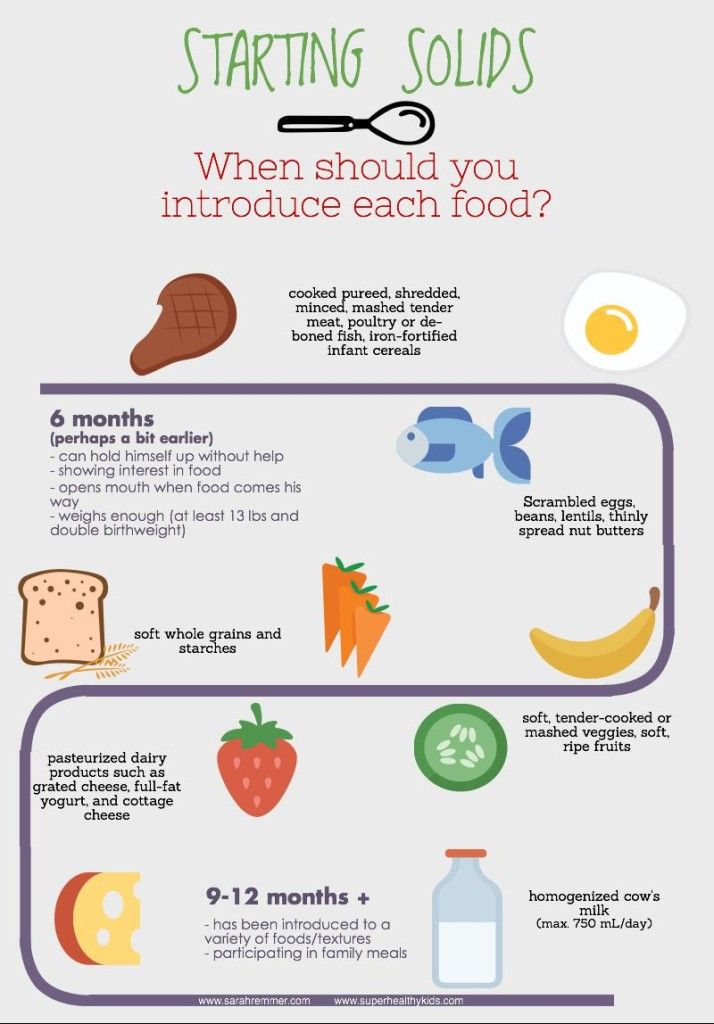 Introduce no more than one new product per day into the child’s menu at 7 months and consult a pediatrician first. After getting acquainted with different foods, up to three complementary foods can be given daily: this can be one or two tablespoons or 115-170 grams (8-12 tablespoons), depending on the baby and the specific product.
Introduce no more than one new product per day into the child’s menu at 7 months and consult a pediatrician first. After getting acquainted with different foods, up to three complementary foods can be given daily: this can be one or two tablespoons or 115-170 grams (8-12 tablespoons), depending on the baby and the specific product.
Important The calculation of servings and the number of feedings depends on the individual characteristics of the development and needs of the child. Therefore, first of all, be guided by the recommendations of your pediatrician and the needs of the baby.
Baby's menu at 7 months: introducing new products
The basis of the diet is still breast milk or infant formula. To diversify the menu, children's adapted food will help: fruit and vegetable purees, milk and dairy-free cereals, juices, as well as some products from the "adult table".
Kashi
At 7 months, dairy-free and milk porridges, along with breast milk, are the basis of a child’s nutrition.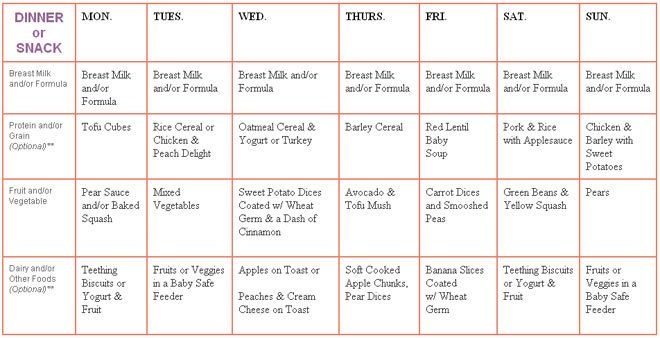 To start complementary foods, choose gluten-free liquid one-component cereals with a high iron content: rice, buckwheat, oatmeal. A little later - corn and semolina. Start complementary foods with half or a whole teaspoon, gradually increasing the serving to 150 grams.
To start complementary foods, choose gluten-free liquid one-component cereals with a high iron content: rice, buckwheat, oatmeal. A little later - corn and semolina. Start complementary foods with half or a whole teaspoon, gradually increasing the serving to 150 grams.
Important Dairy-free porridge is diluted with breast milk or milk formula, milk - with purified boiled water. Find out more: Gerber® Baby Cereals: product range
Vegetable and fruit purees
Vegetable and fruit purees will diversify the diet and introduce new tastes to the baby. According to WHO recommendations, the best product to start with is a one-component vegetable puree made from zucchini, broccoli, cauliflower or potatoes. These vegetables are less allergenic than other foods. If the child does not have allergies, pumpkin, carrot, pea and tomato puree can be given a little later.
Find out more: Gerber® Vegetable Purees
After introducing vegetable purees into your diet, it's time for your baby to get to know sweet and healthy fruit purees. Like vegetable, fruit complementary foods are also recommended to start with one-component low-allergenic foods. Apple, pear or banana puree is best for this. Start with half or a whole teaspoon and gradually increase the serving to 100-150 grams.
Like vegetable, fruit complementary foods are also recommended to start with one-component low-allergenic foods. Apple, pear or banana puree is best for this. Start with half or a whole teaspoon and gradually increase the serving to 100-150 grams.
Learn more: Gerber® 9 fruit purees0006
Your baby's introduction to a variety of flavors is the best place to start with Gerber® vegetable purees, specially formulated for baby's first foods. In the composition - only the vegetable that is indicated on the package, without extraneous additives.
DETAILS
Meat
Meat is a product necessary for development, rich in iron and protein, which is well absorbed in the body. Start with homogenized options. The product must contain only one type of meat (diet turkey, rabbit, chicken, veal) and no additional components. If the crumbs have a tendency to food allergies, choose meat very carefully, it is better to consult a doctor in advance.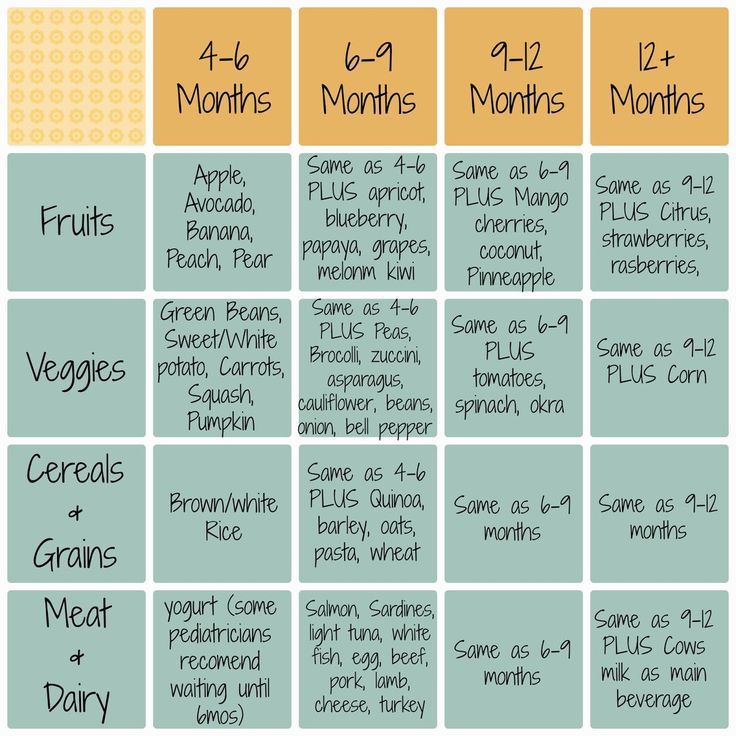 Pay attention to the composition of baby food and its age-appropriate baby. First, let the baby try half a teaspoon. If no adverse reactions occur, gradually increase the meat rate to 60 grams.
Pay attention to the composition of baby food and its age-appropriate baby. First, let the baby try half a teaspoon. If no adverse reactions occur, gradually increase the meat rate to 60 grams.
Learn more: Gerber® Meat Purees
Juices
Fruit juice is great for snacking and diversifying the menu. Young children tolerate clarified apple and pear juice better, so they should be introduced first. Give the baby adapted baby juices: they do not contain sugar or other additives undesirable for the child. Ordinary store-bought juices can only be drunk by children over three years old.
0006 Tip Introduce your baby to juices after the introduction of cereals and vegetable purees. Often the child gets used to sweet juices and then does not eat foods with a less bright taste. Learn more: Gerber® Juices
Egg Yolk
In addition to cereals and purees, boiled egg yolk is introduced at 7 months of age as it is an excellent source of omega fats, selenium, phosphorus and vitamins.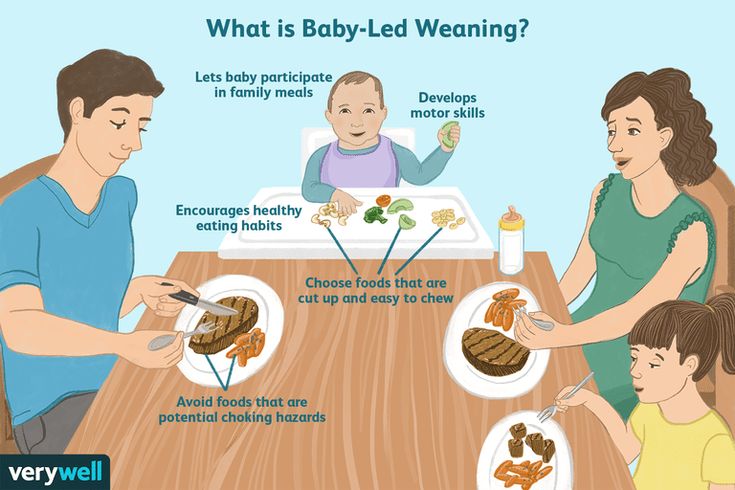 Please note that you need to give the egg not the whole, but only the yolk. But, like any other product that you give to try for the first time, it should be introduced carefully and little by little to make sure that the baby does not have an allergy. Do not combine with other food! Only when you "test" the yolk, it is allowed to add it to cereals and vegetable purees.
Please note that you need to give the egg not the whole, but only the yolk. But, like any other product that you give to try for the first time, it should be introduced carefully and little by little to make sure that the baby does not have an allergy. Do not combine with other food! Only when you "test" the yolk, it is allowed to add it to cereals and vegetable purees.
Important It is believed that allergic children can be fed quail eggs. But it is important to remember that quail eggs can also be allergic, as they also contain egg white - an allergen that is found in chicken eggs. Therefore, do not experiment, but seek the advice of a pediatrician. See also: Introduction of complementary foods to children with food allergies
Baby biscuits and croutons
At seven months, some babies begin to erupt their first teeth. Therefore, you can add crackers and children's cookies to food. But do not forget that they should not be too hard so that the child does not get hurt and choke. It is also better to choose special products without added salt, sugar, synthetic leavening agents and preservatives.
It is also better to choose special products without added salt, sugar, synthetic leavening agents and preservatives.
Important The child should eat solid food in a sitting position and strictly under adult supervision.
Consistency of dishes
The main component of the diet remains liquid and homogeneous (without lumps) - breast milk or milk formula, milk and dairy-free cereals. As the baby grows, the baby's food should change from liquid and homogeneous to thicker and puree, mashed. When the body adapts and is able to digest solid food, they begin to carefully introduce small, medium and coarsely ground foods, give children's cookies and crackers.
At 7 months, some babies already have teeth, but they cannot yet chew thoroughly and safely swallow vegetables, fruits and meat. Therefore, solid food should be given only in a grated form. It is important that the puree is not too thick, otherwise the child may accidentally choke.
Tip If you are preparing puree yourself, carefully remove everything that is not frayed and can get into the respiratory tract of the crumbs: bones, fat, veins, skin, films. To make the puree easier to swallow, add some boiled water, unsalted vegetable broth, vegetable puree already familiar to the baby, or breast milk (milk mixture).
By about 7 months of age, the baby has mastered the skill of “palm grip” and can independently hold solid food in the handle. From now on, you can give your child special baby cookies or snacks. At the same time, make sure that the baby eats slowly, in a sitting position and does not choke.
Important The baby should be ready to receive more viscous or solid food. Therefore, before changing the consistency of food for a child, consult a pediatrician.
Meal schedule and approximate daily menu
What can be given to children at 7 months and at what time to feed? Parents can begin to form a classic division of food consumption per day.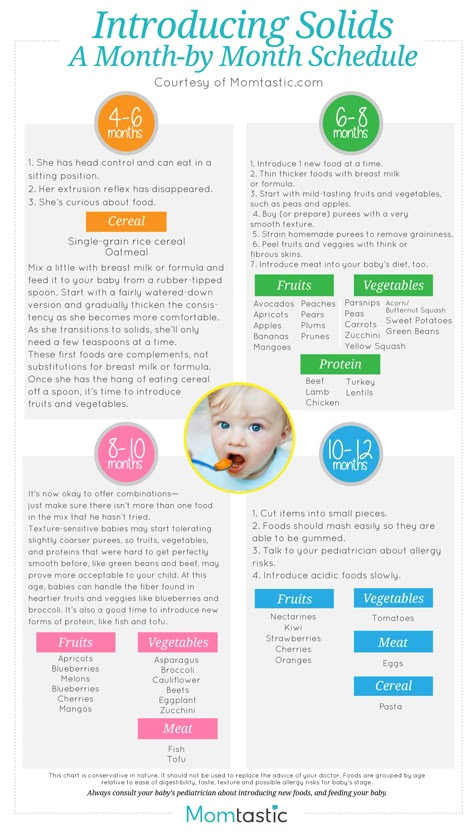 But at 7 months, the baby needs to be fed not three or four, but five times a day at intervals of four hours. The first and final feeding is mother's milk or formula. Complementary foods are not given at this time in order to prevent overeating.
But at 7 months, the baby needs to be fed not three or four, but five times a day at intervals of four hours. The first and final feeding is mother's milk or formula. Complementary foods are not given at this time in order to prevent overeating.
*Dairy-free porridge should be diluted with breast milk or infant formula given to the baby. Milk porridge is diluted with water.
Tip Do not salt or sweeten food. It is better to introduce the baby to sugar and salt after a year.
Sample diet for a 7-month-old baby allergic to cow's milk proteins: table
Nestle® Dairy-Free Rice Cereal*
Vegetable Oil (add to meal)
Gerber® Apple or Williams Pears Fruit Puree
130 g
approx. 1 tsp.
70 g
III feeding
14 hours
Gerber® vegetable puree Broccoli, Cauliflower
Vegetable oil (add to the dish)
Gerber® meat puree 170 g03 with rabbit 90 g02
about 1 tsp.
30 g
IV feeding
18 hours
Vegetable puree or dairy-free porridge**
Vegetable oil (add to the meal)
Gerber® Tender Turkey Meat Puree
170 g
approx. 1 tsp.
20 g
V feeding
22 hours
Breast milk or therapeutic formula for children with intolerance to cow's milk proteins
200 ml
**you can either alternate porridge or vegetables, or offer a mixed dish - porridge with vegetables.
Now you know what products and in what form can be introduced into the menu of a child at 7 months. It is preferable if it is certified baby food that meets all age requirements and high safety standards.
See also: Do we cook ourselves or use baby food?
FAQ
1. At what age should we start complementary foods?
The World Health Organization (WHO) recommends introducing complementary foods to your baby's menu at 6 months of age.